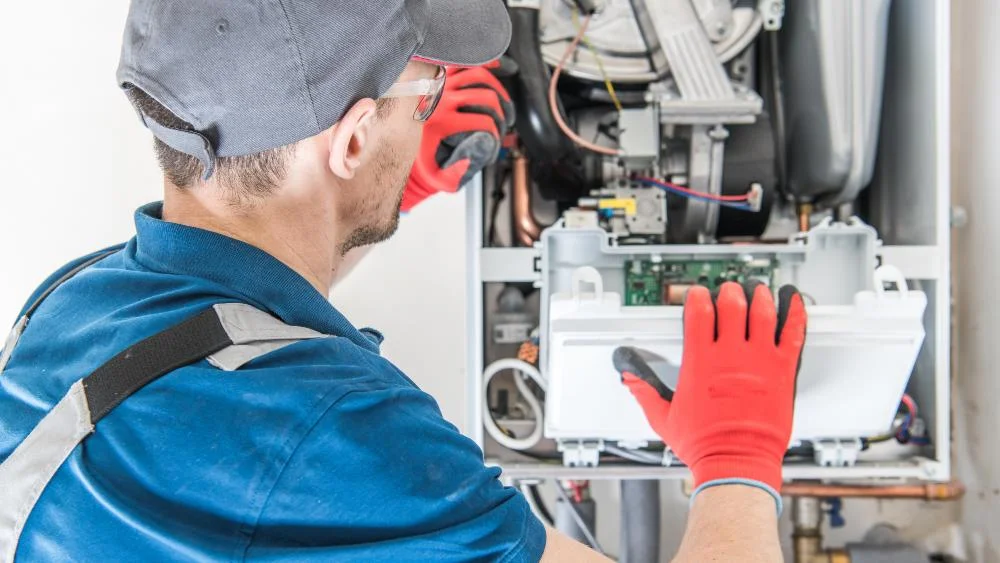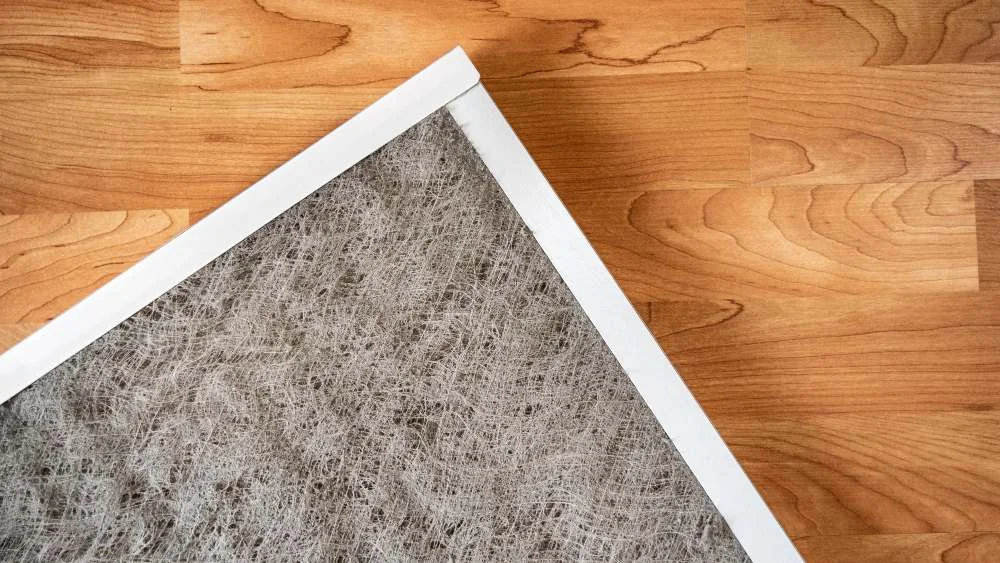
Key Takeaways
- Furnace short cycling increases energy consumption, reduces heating efficiency, and can shorten the system’s lifespan.
- Issues like dirty air filters, thermostat malfunctions, blocked vents, oversized unit, and overheating can result in the furnace cycling on and off.
- Short cycling can be dangerous and may lead to carbon monoxide buildup in gas furnaces.
Is your furnace constantly turning on and off without keeping your home warm? This could be a sign of short cycling. It can happen for several reasons and can compromise your comfort as well as the efficiency of the system. You can also end up with high energy bills despite your home not being sufficiently warm.
So, what exactly is a furnace short-cycling? Why does it happen, and how can you fix it? Let’s find out!
What is Furnace Short-Cycling?
A furnace short-cycles when it turns on and off more frequently without reaching its set temperature. The cycle length also becomes short. Usually, a furnace runs for a time period that is sufficient to heat up a home before turning off. This can vary depending on your heating needs, your furnace size, and your fuel source. Short cycling interrupts the normal cycle and causes the furnace to turn off before it has effectively heated the space.
Suppose your thermostat is set to 68F. When the temperature drops to 63F, the furnace kicks on to heat the house. However, the furnace shuts off once the temperature reaches 65F instead of the desired 68F. After a short time, the temperature falls again, causing the furnace to turn on once more, repeating this on-and-off cycle without actually reaching the set temperature.
This can impact your comfort and may even affect the health of your family, especially if you have elderly or children around. Moreover, it reduces the furnace’s efficiency, increases wear and tear on its components, and drives up heating costs. Understanding the causes and effects of short cycling can help you address the issue before it leads to costly repairs.
Signs That Your Furnace Is Short-Cycling
Here are the top signs that you are dealing with a short-cycling furnace:
-
Home & Thermostat Temperature Difference
One of the clearest signs of furnace short-cycling is a never-ending difference between your home temperature and your thermostat setpoint. If your home temperature rises during the heating cycle but consistently fails to reach the set temperature, then furnace short-cycling can be one cause.
-
Short, Frequent On-Off Cycles
The biggest warning sign is when the heating cycles get shorter and more frequent. They may occur five to eight times per hour. The exact frequency depends on the outdoor weather conditions and your home insulation. The cycle length may also be reduced to less than 5 minutes.
-
Inconsistent Home Temperature

If you have ever felt like the temperature in your home fluctuates drastically, with hot and cold spots throughout, this can be a telltale. This can be due to the furnace not running for long enough to maintain a comfortable and consistent temperature in your home.
-
Reduced Airflow
Another sign of a short-cycling furnace is weak airflow from the vents. This can happen because the heating system is not working long enough to push sufficient warm air into the ducts.
Related: Furnace Not Blowing Hot Air: 16 Reasons & Repair Tips
-
Frequent Repairs
Short-cycling can cause wear and tear on the furnace’s components. This often means more frequent repair runs or even replacement for a few parts.
What Causes A Furnace to Short-Cycle & How Can You Troubleshoot It?
Here are the top reasons why your heating unit is turning on and off frequently and what can you do about it:
1. Dirty Filters

Airflow is restricted when air filters are dirty and clogged. This causes the furnace to work harder and results in wear and tear.
To fix furnace short-cycling due to clogged filters, you should replace them at least once a year. The frequency can increase depending on the area you live in and if you have pets at home. Maintaining a clean air filter allows for proper airflow, improves indoor air quality, and reduces the risk of short cycling.
2. Incorrect Thermostat Location
The placement of your thermostat plays a vital role in your furnace cycling behavior. If the thermostat is placed near direct sunlight or near a drafty area, it can misread the temperature of your home and show wrong readings. This can cause the furnace to shut off prematurely or kick on unnecessarily.
Ensure that your thermostat is in a central location, like a living room, away from heat-generating appliances or cold drafts.
3. Thermostat Malfunction
A malfunctioning thermostat can cause your furnace to short-cycle. If your thermostat is battery-operated, check its batteries and replace them if necessary. If you can’t find what’s causing the issue, contact a professional. Also, make sure your thermostat is properly calibrated.
Faulty wiring or connections between the thermostat and your furnace can impact communication, leading to short cycling. Ask a professional to inspect the wiring.
4. Lack of Maintenance
A furnace that isn’t cleaned regularly can lead to a host of problems, including short-cycling.
Scheduling furnace maintenance with a professional HVAC technician can help identify any underlying issues before they escalate.
During a maintenance check, the HVAC technician will inspect any potential issues with your HVAC system that might lead to short cycling of the furnace, such as airflow issues or a damaged heat exchanger. The professional will also thoroughly clean the furnace components, such as the frame sensor and furnace filters. This routine maintenance call will help your system run efficiently, extend its lifespan, and avoid unexpected breakdowns during peak season.
This would cost you around $150 but can go up to $400, depending on various factors like furnace type, size, and location in your home.
5. Ignition Issue
Your furnace can short-cycle when it struggles to ignite or maintain a steady flame. This can be due to issues with the ignition system, which might prevent the furnace from starting or keeping a consistent flame. An HVAC technician can diagnose and fix these problems.
Another reason can be an inadequate gas supply or a faulty gas valve. These can prevent your furnace from igniting properly. An HVAC technician can diagnose and fix these problems.
6. Vents Obstruction
If your vents are obstructed, they can cause several problems, such as preventing proper airflow throughout your home. When this happens, the furnace fails to distribute the heating evenly, which causes it to shut down prematurely.
Check all your air vents and clear all the obstructions.
7. Faulty Electrical Board
A faulty electrical board also causes your furnace to short-cycle, as it won’t send the right signals to furnace components.
You can contact a technician who can diagnose and repair the electric board issue.
8. Oversized Furnace
An oversized furnace will heat your home too quickly, preventing a complete cycle, only to turn on again shortly after. This constant turning on and off process places unnecessary strain on your system.
Installing the right-sized furnace for your home can help prevent short cycling. If you suspect your furnace is too large, consulting with an HVAC professional to evaluate your furnace size and home heating needs can help. They may recommend replacing the unit with one that better matches the square footage and insulation level of your home, which will promote longer, more efficient cycles.
9. Dirty Flame Sensor
The flame sensor informs the furnace that a flame is present when the gas valve opens. If the sensor can’t detect the flame, the furnace shuts down.
This can happen when the sensor becomes dirty due to lack of maintenance. To clean it, power off your furnace. Then, use a hex driver or socket wrench to remove the flame sensor. Once it’s removed, gently clean the sensor by rubbing it with fine steel wool or fine-grit sandpaper to remove any buildup. If it’s extremely dirty, it’s best to replace it.
Note: It is highly important to keep the flame sensor clean. If the gas valve is open and emitting gas but there’s no flame, gas can build up in your house, which can be extremely dangerous.
10. Clogged Flue
The flue expels dangerous gases outside. It can sometimes get clogged with dirt and debris, a bird’s nest, or a dead rodent. Once it’s blocked, your furnace will shut down to prevent gases from accumulating in your home.
You can fix it by disassembling the flue and thoroughly checking it with a flashlight. Clear away any obstructions and reassemble.
11. Furnace Overheating
Your furnace can get overheated when the internal components, like the heat exchanger, are not working how they are supposed to. Due to overheating, the furnace shuts down automatically in order to protect itself and catching fire.
A cracked or defective heat exchanger can leak heat into other parts of the furnace, leading to overheating and triggering short cycling. In severe cases, this could cause more serious damage to the system.
12. Defective Fan Limit Switch
This component controls the system when the furnace blower turns on and off. It acts as a gatekeeper for hot air circulation and shuts down the furnace if overheating is detected.
Since fan limit switches are sealed components, the only solution is to replace them. Contact a furnace technician to have it replaced.
13. Damaged Blower
The blower helps circulate air throughout your home. If the blower isn’t working, the lack of air circulation quickly raises the temperature inside the furnace, causing it to shut down for safety reasons.
If your furnace keeps shutting down, go to your vents and feel the airflow. If there is little to no air, it’s likely a problem with the blower. Call an HVAC professional for repairs.
Is Furnace Short-Cycling Dangerous?
Andriy Boyko, founder of A.O. Handy Inc., says, “As a handyman, I’ve seen how small issues with furnaces can snowball into bigger, more expensive problems if they aren’t addressed. Short-cycling is one of those sneaky issues.”
When a furnace is constantly starting and stopping, it puts a strain on the internal components. “This can affect the furnace’s ability to vent properly. For gas furnaces, that’s a major concern because improper venting can lead to dangerous situations, like the buildup of carbon monoxide (CO). This is why it’s crucial to address short-cycling as soon as you notice it,” Bokyo adds.
When to Call a Professional
If you have checked the air filter, thermostat, and vents, but your furnace is still short-cycling, it’s time to call a professional.
Short cycling can be caused by more complex issues, such as a faulty flame sensor or overheating components, which require expert diagnosis and repair. A licensed HVAC technician can perform a thorough inspection and address underlying problems to prevent further damage and ensure safe, efficient operation.
When to Replace Your Furnace
Age of the Furnace
Furnaces typically last 15 to 20 years. If yours is nearing this age and requires frequent repairs, and if your HVAC system struggles to heat your home effectively, it may be time to replace it. Older furnaces also lack the efficiency of technology that comes with the newer models, making repairs less cost-effective over time.
Efficiency Considerations
Upgrading to a modern, energy-efficient furnace can lead to significant cost savings on energy bills. A properly sized unit prevents a furnace short-cycle, ensures consistent heating, and reduces energy waste. Over time, the increased efficiency can help offset the cost of a new furnace. You can also pair it with smart thermostats and utilize a plethora of smart features that cut down energy wastage even further.
Related: The Ultimate Furnace Replacement Guide for 2024
Equip your HVAC system with smart features and achieve the perfect balance between comfort & savings.
Learn more
In Conclusion
A short-cycling furnace is more than just an inconvenience. Consider this a warning alarm for your system. It can significantly impact both the efficiency and lifespan of your heating system. It occurs when the furnace turns on and off too frequently, failing to maintain a consistent temperature in your home. The causes can vary from dirty air filters and thermostat malfunctions to more serious issues like faulty components or improper furnace sizing. By understanding why your furnace short-cycles and addressing the issues early, you can keep your system running smoothly throughout the heating season.









1 Comment. Leave new
This is a very thorough and informative article! I appreciate how it breaks down the many reasons a furnace might short-cycle and offers clear guidance on how to address each one. It’s a great resource for homeowners who want to troubleshoot issues before calling a technician.